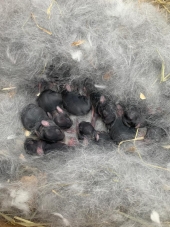Hey y'all,
I am starting an adventure into raising meat rabbits in the Southeastern USA. I have some supplies and will be building my hutch come this May. The area I live in gets very warm days, but does get some relief in the night time, so from my research on rabbit environs I can make this happen with underground access and cooling areas. My hutch will be entirely on the ground, as I had some rabbits injure themselves gravely growing up from falling off a platform in a 'rabbit-safe' commercial hutch. It will be in a cross shape, with nesting boxes/covered area at the peak, food/water area in the right arm, a cooling area with slate and marble flat stones in the left arm, and the main grazing run as the lower portion. Alternate/summer nesting options include two underground spaces, lined completely with stone pavers I have left over to prevent them from digging out, with a wooden roof and soil topping that with a PVC pipe (5-6" diameter) entering the spaces for easy rabbit access.( I will also most likely line this with faux turf or rubber to help the kits enter/exit) The mesh of the entire hutch will also extend into the ground about 1', mainly to keep coyotes out but also keep bunnies in. I may need to consider a secondary wire encasement, or electric fence in the future.
I do not like the idea of wire/mesh hutches, so that's a no go. I will also be feeding them a diet of 10/10/80 concentrate (cost wise this will be Manna Pro Select as it has the best nutritional spread and a good amount of fiber), forage which will consist of harvested weeds, tree limbs and other greens growing on the property, and the rest hay. I will start them on timothy or whatever the breeder last had them on, and try to convert them to local coastal grass, which we feed the horses and I can get in round bales. I would love to transfer them to all forage and self-made hay in the future, but I'm aware that their diets changing suddenly can be very bad for their health, so I will try this in time. They will also have access to mineral salt licks, and their lives will be supplemented with engaging wooden toys and scraps from my fooling around in the shop. I think its needless to say I am excited to get these little buggers!
Both the cooling and feeding area will have access to drip water bottles, and I have the capabilities to run electric out there for a fan or two. The whole design will be placed under the shade of cedar trees, and will still get good airflow. Still deciding the dimensions of the entire hutch, but I should be able to post a photo of the plan in the future. If anyone with experience would be willing to share some insight, tips/tricks on keeping rabbits in the heat, what breeds to start out with, any kind of knowledge that would classify as word of mouth or learned on job would be very appreciated. I'm no stranger to farming and the realities of keeping animals, but I am trying to do my best the first time around.
Thank you all for all you do, I am very grateful for any advice given.



